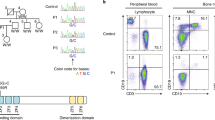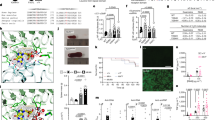Abstract
The functional interaction of BAFF and APRIL with TNF receptor superfamily members BAFFR, TACI and BCMA is crucial for development and maintenance of humoral immunity in mice and humans. Using a candidate gene approach, we identified homozygous and heterozygous mutations in TNFRSF13B, encoding TACI, in 13 individuals with common variable immunodeficiency. Homozygosity with respect to mutations causing the amino acid substitutions S144X and C104R abrogated APRIL binding and resulted in loss of TACI function, as evidenced by impaired proliferative response to IgM-APRIL costimulation and defective class switch recombination induced by IL-10 and APRIL or BAFF. Family members heterozygous with respect to the C104R mutation and individuals with sporadic common variable immunodeficiency who were heterozygous with respect to the amino acid substitutions A181E, S194X and R202H had humoral immunodeficiency. Although signs of autoimmunity and lymphoproliferation are evident, the human phenotype differs from that of the Tnfrsf13b−/− mouse model.
This is a preview of subscription content, access via your institution
Access options
Subscribe to this journal
Receive 12 print issues and online access
$209.00 per year
only $17.42 per issue
Buy this article
- Purchase on Springer Link
- Instant access to full article PDF
Prices may be subject to local taxes which are calculated during checkout





Similar content being viewed by others
Accession codes
References
Mackay, F. & Ambrose, C. The TNF family members BAFF and APRIL: the growing complexity. Cytokine Growth Factor Rev. 14, 311–324 (2003).
Mackay, F., Schneider, P., Rennert, P. & Browning, J. BAFF AND APRIL: a tutorial on B cell survival. Annu. Rev. Immunol. 21, 231–264 (2003).
Ng, L.G. et al. B cell-activating factor belonging to the TNF family (BAFF)-R is the principal BAFF receptor facilitating BAFF costimulation of circulating T and B cells. J. Immunol. 173, 807–817 (2004).
Avery, D. et al. BAFF selectively enhances the survival of plasmablasts generated from activated human memory B cells. J. Clin. Invest. 112, 286–297 (2003).
Wu, Y. et al. Tumor necrosis factor (TNF) receptor superfamily member TACI is a high affinity receptor for TNF family members APRIL and BlyS 275. J. Biol. Chem. 275, 35478–35485 (2000).
Varfolomeev, E. et al. APRIL-deficient mice have normal immune system development. Mol. Cell. Biol. 24, 997–1006 (2004).
Castigli, E. et al. Impaired IgA class switching in APRIL-deficient mice. Proc. Natl. Acad. Sci. USA 101, 3903–3908 (2004).
Litinskiy, M.B. et al. DCs induce CD40-independent immunoglobulin class switching through BLyS and APRIL. Nat. Immunol. 3, 822–829 (2002).
Castigli, E. et al. TACI and BAFF-R mediate isotype switching in B cells. J. Exp. Med. 201, 35–39 (2005).
Schiemann, B. et al. An essential role for BAFF in the normal development of B cells through a BCMA-independent pathway. Science 293, 2111–2114 (2001).
Thompson, J.S. et al. BAFF-R a newly identified TNF receptor that specifically interacts with BAFF. Science 293, 2108–2111 (2001).
Shulga-Morskaya, S. et al. B cell-activating factor belonging to the TNF family acts through separate receptors to support B cell survival and T cell-independent antibody formation. J. Immunol. 173, 2331–2341 (2004).
von Bülow, G.U., van Deursen, J.M. & Bram, R.J. Regulation of the T-independent humoral response by TACI. Immunity 14, 573–582 (2001).
Seshasayee, D. et al. Loss of TACI causes fatal lymphoproliferation and autoimmunity, establishing TACI as an inhibitory BLyS receptor. Immunity 18, 279–288 (2003).
Yan, M. et al. Activation and accumulation of B cells in TACI-deficient mice. Nat. Immunol. 2, 638–643 (2001).
Cunningham-Rundles, C. & Bodian, C. Common variable immunodeficiency: clinical and immunological features of 248 patients. Clin. Immunol. 92, 34–48 (1999).
Vořechovský, I., Cullen, M., Carrington, M., Hammarström, L. & Webster, A.D.B. Fine mapping of IGAD1 in IgA deficiency and common variable immunodeficiency: Identification and characterization of haplotypes shared by affected members of 101 multiple-case families. J. Immunol. 164, 4408–4416 (2000).
Burrows, P.D. & Cooper, M.D. IgA deficiency. Adv. Immunol. 65, 245–276 (1997).
Grimbacher, B. et al. Homozygous loss of ICOS is associated with adult-onset common variable immunodeficiency. Nat. Immunol. 4, 261–268 (2003).
Salzer, U. et al. ICOS deficiency in patients with common variable immuno-deficiency. Clin. Immunol. 113, 234–240 (2004).
Hymowitz, S.G. et al. Structures of APRIL-receptor complexes: Like BCMA, TACI employs only a single cysteine-rich domain for high-affinity ligand binding. J. Biol. Chem. 280, 7218–7227 (2004).
Riva, A. & Kohane, I.S. SNPper: retrieval and analysis of human SNPs. Bioinformatics 18, 1681–1685 (2002).
Ng, P.C. & Henikoff, S. SIFT: Predicting amino acid changes that affect protein function. Nucleic Acids Res. 31, 3812–3814 (2003).
Ingold, K. et al. Identification of proteoglycans as APRIL-specific binding partners. J. Exp. Med. 201, 1375–1383 (2005).
Warnatz, K. et al. Severe deficiency of switched memory B cells (CD27+IgM−IgD−) in subgroups of patients with common variable immunodeficiency: a new approach to classify a heterogeneous disease. Blood 99, 1544–1551 (2002).
Kralovicova, J., Hammarström, L., Plebani, A., Webster, A.D.B. & Vorechovsky, I. Fine-scale mapping at IGAD1 and genome-wide genetic linkage analysis implicate HLA-DQ/DR as a major susceptibility locus in selective IgA deficiency and common variable immunodeficiency. J. Immunol. 170, 2765–2775 (2003).
McDermott, M.F. et al. Germline mutations in the extracellular domains of the 55 kDa TNF receptor, TNFR1, define a family of dominantly inherited autoinflammatory syndromes. Cell 97, 133–144 (1999).
Ferrari, S. et al. Mutations of CD40 gene cause an autosomal recessive form of immunodeficiency with hyper IgM. Proc. Natl. Acad. Sci. USA 98, 12614–12619 (2001).
Rieux-Laucat, F. et al. Mutations in Fas associated with human lymphoproliferative syndrome and autoimmunity. Science 268, 1347–1349 (1995).
Infante, A.J. et al. The clinical spectrum in a large kindred with autoimmune lymphoproliferative syndrome caused by a Fas mutation that impairs lymphocyte apoptosis. J. Pediatr. 133, 629–633 (1998).
Fisher, G.H. et al. Dominant interfering Fas gene mutations impair apoptosis in a human autoimmune lymphoproliferative syndrome. Cell 81, 935–946 (1995).
Holler, N. et al. Two adjacent trimeric Fas ligands are required for Fas signaling and formation of a death-inducing signaling complex. Mol. Cell. Biol. 23, 1428–1440 (2003).
Wu, H. Assembly of post-receptor signaling complexes for the tumor necrosis factor receptor superfamily. Adv. Protein Chem. 68, 225–279 (2004).
Xia, X.Z. et al. TACI is a TRAF-interacting receptor for TALL-1, a tumor necrosis factor family member involved in B cell regulation. J. Exp. Med. 192, 137–143 (2000).
Siegel, R.M. et al. Fas preassociation required for apoptosis signaling and dominant inhibition by pathogenic mutations. Science 288, 2354–2357 (2000).
Gross, J.A. et al. TACI-Ig neutralizes molecules critical for B cell development and autoimmune disease. Impaired B cell maturation in mice lacking BLyS. Immunity 15, 289–302 (2001).
Baker, K.P. et al. Generation and characterization of LymphoStat-B, a human monoclonal antibody that anatgonizes the bioactivities of B Lymphocyte Stimulator. Arthritis Rheum. 48, 3253–3265 (2003).
Hannelius, U. et al. Phenylketonuria screening registry as a resource for population genetic studies. J. Med. Genet. (in the press).
Pan, Q., Lindersson, Y., Sideras, P. & Hammarström, L. Structural analysis of human γ3 intervening regions and switch regions: implication for the low frequency of switching in IgG3-deficient patients. Eur. J. Immunol. 27, 2920–2926 (1997).
Lathrop, G.M., Lalouel, J.M., Julier, C. & Ott, J. Strategies for multilocus analysis in humans. Proc. Natl. Acad. Sci. USA 81, 3443–3446 (1984).
Cottingham, R.W. Jr ., Idury, R.M. & Schäffer, A.A. Faster sequential genetic linkage computations. Am. J. Hum. Genet. 53, 252–263 (1993).
Acknowledgements
We thank H. Eibel and K. Warnatz for advice; J. Deimel, R. Dräger, B. Ferry, M. Ibrahim, K. Ingold, J. Pfannstiel, A. Rump, A. Tardivel, M. Vogel, S. Workman and C. Woellner for assistance; A.-M. Eades-Perner, J. Puck and U. Walker for critically reading the manuscript; U. Hannelius and J. Kere for sharing their material and method for population-based screening; E. Walther for providing the tonsil specimens; and I. Vořechovský for providing the genotypes of CVID families. This research was supported by grants from the Deutsche Forschungsgemeinschaft, the Swedish research council and the European Union.
Author information
Authors and Affiliations
Corresponding author
Ethics declarations
Competing interests
The authors declare no competing financial interests.
Supplementary information
Supplementary Fig. 1
Expression of TACI and BAFFR. (PDF 35 kb)
Supplementary Fig. 2
ELISA for detection of soluble TACI. (PDF 11 kb)
Supplementary Fig. 3
Proliferation of enriched B cells in response to anti-IgM, anti-IgM plus interleukin (IL)-2, snti-CD40, and anti-CD40 plus IL-4. (PDF 11 kb)
Supplementary Table 1
Clinical summary of patients with mutations in TNFRSF13B. (PDF 14 kb)
Supplementary Table 2
Primer sequences used in this study. (PDF 18 kb)
Rights and permissions
About this article
Cite this article
Salzer, U., Chapel, H., Webster, A. et al. Mutations in TNFRSF13B encoding TACI are associated with common variable immunodeficiency in humans. Nat Genet 37, 820–828 (2005). https://doi.org/10.1038/ng1600
Received:
Accepted:
Published:
Issue Date:
DOI: https://doi.org/10.1038/ng1600
This article is cited by
-
Enrichment of Immune Dysregulation Disorders in Adult Patients with Human Inborn Errors of Immunity
Journal of Clinical Immunology (2024)
-
Inflammatory and infectious upper respiratory diseases associate with 41 genomic loci and type 2 inflammation
Nature Communications (2023)
-
Clinical and immunological characterisation of patients with common variable immunodeficiency related immune thrombocytopenia
Clinical and Experimental Medicine (2023)
-
Bowel Histology of CVID Patients Reveals Distinct Patterns of Mucosal Inflammation
Journal of Clinical Immunology (2022)
-
Autoimmunity in Primary Immunodeficiencies (PID)
Clinical Reviews in Allergy & Immunology (2022)



